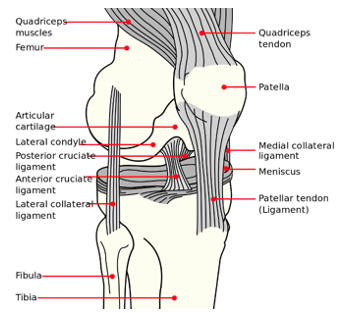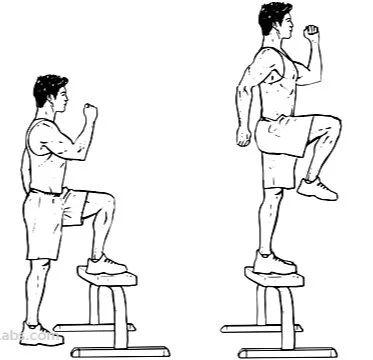Best Exercises to Treat Knee Tendonitis
Knee pain can often incite fear and anxiety into people. It is not uncommon for individuals to develop pain in their knee at some point in their lives. If you have recently been diagnosed by a health care professional, or have a strong suspicion of tendinopathy in your knee you might be wondering what the best course of treatment is. Our expert physiotherapists are here to help and provide some insight on how to manage this pain so you can get back to the things you love.
What is knee tendonitis?
Knee tendonitis is an often painful condition which is commonly known as patellar tendonitis and/or jumper’s knee (Mayo Clinic Staff, 2019; Hecht, 2018). Knee tendonitis is an inflammation of the patellar tendon of the quadricep muscles (thigh muscles) that runs over the patella. This tendon is important for the contraction of the quadricep muscles. This tendon originates from the thigh muscles and inserts itself into the bone of your shin (the tibia) (Mayo Clinic Staff, 2019; Hecht, 2018).
Why is it also called jumper’s knee?
Knee tendonitis is often found in athletes who jump a lot (Mayo Clinic Staff, 2019; Hecht, 2018; Precision Movement by Eric Wong, 2017). For instance, basketball and volleyball players are often face this diagnosis especially if they are playing many consecutive games. (Mayo Clinic Staff, 2019; Hecht, 2018; Precision Movement by Eric Wong, 2017).
What are the symptoms of tendonitis in the knee?
Symptoms associated with a diagnosis of tendonitis in the knee, patients often experience pain at and around the patella/kneecap (Mayo Clinic Staff, 2019). Specifically, the pain is often localized at the patellar tendon which is situated between the patella and the tibia bones.
Pain is often felt behind the knee when bending or straightening the leg, such as during walking and squatting. This may result in pain and inability to bend at the knee. In severe cases, there may be a burning sensation at the knee as well which can indicate nerve involvement.
Why do people get patellar tendonitis?
People often get patellar tendonitis because of the overuse of the tendon. When there is constant stress with insufficient recovery time the tendon begins to change. You can think of this similiar to a rope beginning to fray. For instance, an overactive basketball player who plays basketball for several hours every day without sufficient rest may begin to develop this condition. This is often compounded by fatigue, diet, training errors, and muscle imbalances. (Mayo Clinic Staff, 2019; Hecht, 2018)
Individuals who suddenly change their activity may also develop this condition. For instance, an office worker who was previously sedentary begins training for a 10km run with her colleagues is prone to developing patellar tendonitis.
For some individuals, changes in footwear may cause the onset or aggravate this condition. It is important to have proper foot which match your individual foot structure if this is the case.
It is always important to ascertain the root cause of this injury. If not, it is extremely
likely to recur or worsen.
How does one treat, heal, cure, and/or fix knee tendonitis?
Many individuals that experience pain in their knee are confused as to what the best course of treatment is. This will vary depending on what stage the disease is in. Treatment for knee tendonitis includes:
Medication & Bracing - Initially a period of rest, as well as using ice, and avoiding aggravating activities which trigger symptoms (i.e. jumping) may be required. Medications such as Acetaminophen, Ibuprofen, and Naproxen Sodium may be taken or prescribed as well. In some cases, the use of a patellar tendon strap or brace may be used to alleviate pain during functional activities.
Physiotherapy - Physical therapy aims to use specialized modalities such as soft tissue mobilization, taping, dry needling, ultrasound, muscle stimulation, and shockwave among others to quicken recovery.Moreover, specific corrective exercises which help to strengthen and stretch the muscles of the lower limb are required for successful rehabilitation. These exercises may vary given the cause of the individual’s root cause of injury. These are often prescribed by a Physiotherapist after a functional physical examination.
Injections - If the injury is deemed severe, suitable patients may require further intervention. Sometimes the use of a corticosteroid injection may be used, however, this may do harm as it can actually weaken the tendon and lead to rupture over time (Mayo Clinic Staff, 2019; Hecht, 2018)
PRP Treatments - Platelet-rich plasma injections (Mayo Clinic Staff, 2019), oscillating needle procedures (helps to “cut away the damaged” region) (Mayo Clinic Staff, 2019), ultrasound guided dry needling “making small holes in the tendon” (Hecht, 2018), hyperthermia thermotherapy (uses heating deep within the tissue and cooling devices on the surface) (Hecht, 2018), and extracorporeal shockwave therapy (Hecht, 2018) are alternative invasive measures that may be used for treatment.
Surgery - In very serious cases, surgery may be the last option for chronic knee tendonitis that cant be resolved conservativly. Generally, it is extremely rare that people will require surgery as knee tendinitis can be treated through proper physical therapy and exercise (Mayo Clinic Staff, 2019).
Strengthening Exercises for Knee Tendonitis:
Because there are many muscles that cross the knee joint and can potentially have an effect on the knee, there would be multiple patellar tendonitis exercises used to help treat it. It has also been noted that one should focus more on eccentric (when the muscles lengthen) and concentric (when the muscles shorten) exercises (Hecht, 2018). Some exercises that can help to strengthen the muscles around the knee would be:
Squats
(Bodyweight and/or weighted, depending on the performer’s abilities)
o Drop squats (stepping off a raised height, typically a box, and squat on the landing) (Precision Movement by Eric Wong, 2017)
o Decline squats (squatting with a propped-up heel; by stepping on an object with only the heel, in which would form a 15-25⁰ angle with the floor) (Precision Movement by Eric Wong, 2017)
Step-ups/downs:
3 sets of 10 repetitions
o Step up onto an object and down the object, such as a box or staircase step
Clam shells:
3 sets of 10 repetitions
o Lying down on one’s side, legs and feet together in the form of a knee tuck, open up the legs by swinging open just the knee while keeping the feet together and the hip parallel with the floor surface
Hip bridges:
3 sets of 10 repetitions
o Lie supine (back is on the floor) with one’s legs (both) flexed at the knee, then raise one’s glute up reaching a parallel with the thigh
Straight leg raises:
3 sets of 10 repetitions
o Raise one’s leg when lying supine, prone (belly is on the floor), and on their side
All these exercises focus on more than one muscle/muscle group because as previously noted, many muscles cross the knee joint. Furthermore, individuals will have to come up with an appropriate number of repetitions and sets to ensure that the exercise is useful and/or helpful. Very generally, one can start off with 8-12 repetitions and work from there. If too difficult, one can decrease the number of repetitions and if it was too easy, one can increase the number of repetitions or add weights to the exercises. It is especially important to keep in mind the proper form/technique used in these exercises because incorrect form can decrease the effectiveness of them.
Stretching Exercises for Knee Tendonitis:
When exercising, one must also be aware of muscle tightness that develops. It is important for one to stretch out their muscles as tight muscles may also contribute to patellar tendonitis (Mayo Clinic Staff, 2019; Hecht, 2018). Some stretches include:
Quadricep stretches:
60 second hold for 3 sets
o While standing on one leg, use hands to help bring the heel of the other leg up towards one’s bottom
o One can also use a resistance band to help pull the leg towards one’s bottom when lying prone on the floor
Hamstring stretches:
60 second hold for 3 sets
o Sitting down on a surface with legs extended, bend down and try to reach for one’s toes, while maintaining a neutral posture or straight back
Calf stretches:
60 second hold for 3 sets
o Lying supine, one can dorsiflex their foot (bend at their ankle and bring their foot closer towards them, similar to when releasing a gas pedal) and plantarflex their foot (bend one’s foot at the ankle joint, similar to pushing down on a pedal)
When stretching, be sure to feel a stretch and not pain. It doesn’t necessarily have to be a hard/painful stretch, rather it would be sufficient if it was a comfortable stretch, a stretch that is tolerable and not painful.
Summary
In conclusion, patellar tendonitis is an inflammation in the tendons coming from the knee region causing pain and discomfort. Knee tendonitis is treatable through sufficient rest and exercises to help strengthen and stretch out the muscles that cross the knee joint. However, if pain resides, consult a doctor, trained physician, or Physiotherapist. Regardless, it would be wise to consult them early on to prevent the injury from getting worse.
By taking the appropriate steps and beginning treatment early you should be able to return to activities within as little as 4 weeks.
If you’re unsure of what to do, an expert opinion is always the best option. Our physiotherapists are available to thoroughly investigate this condition, the cause, and what best you can do to get back on the right track!
Read Related Articles
References
AskDoctor Jo. (February 13, 2017). Knee Tendonitis Exercises & Stretches – Ask Doctor Jo. [Video]. Youtube. https://www.youtube.com/watch?v=13G6utHzr9E
Healthwise Staff. (2019, June 26). Patellar Tendinitis (Jumper’s Knee): Exercises. MyHealth.Alberta.ca. https://myhealth.alberta.ca/Health/aftercareinformation/pages/conditions.aspx?hwid=bo1598
Hecht, M. (2018, September 3). What Is Patellar Tendonitis (Jumper’s Knee)? healthline. https://www.healthline.com/health/patellar-tendonitis
Mayo Clinic Staff. (2019, October 19). Patellar Tendinitis. Mayo Clinic. https://www.mayoclinic.org/diseases-conditions/patellar-tendinitis/symptoms-causes/syc-20376113
Mayo Clinic Staff. (2019, October 19). Patellar Tendinitis. Mayo Clinic. https://www.mayoclinic.org/diseases-conditions/patellar-tendinitis/diagnosis-treatment/drc-20376118
Precision Movement by Eric Wong. (May 29, 2017). Patellar Tendonitis Exercises to Treat and Prevent Knee Pain. [Video]. Youtube. https://www.youtube.com/watch?v=JGSIk1lbE6E

















